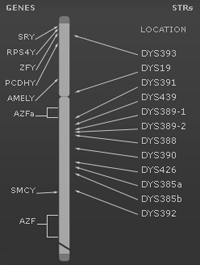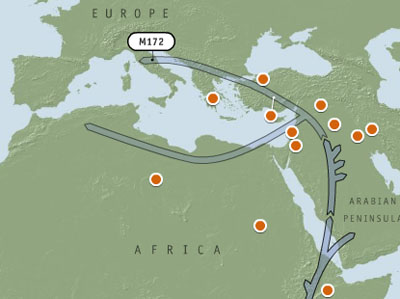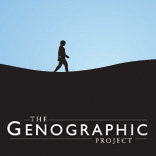Macro-genealogy

A little while ago I posted the results of my participation in the Genographic Project, a comprehensive attempt to fill the holes in our knowledge of human migratory patterns around the globe based on genetic evidence. I just finished Spencer Wells’s short, accessible introduction to this topic and, coincidentally, spent a 14-hour plane flight sitting next to the producer of a documentary who is using this data to help African-Americans determine their home areas in Africa in the absence of genealogical information. (Sitting next to him wasn’t coincidence; he’s with me on business. That we’re both interested in population genetics is coincidence.) So I understand things a lot better now.
The first realization is how incomplete the picture is. The Genographic Project looks for markers (chromosomal mutations passed on from generation to generation) in the Y chromosome for men and in mitochondrial DNA for women. What this means is that my information only reflects my lineage via my father and his father and his father and so on (called the “patrilineal line”). At the very least I’m missing the story from my other three grandparents. Three of them are deceased, but luckily I have relatives who can be tested.
Here’s what I know so far. My patrilineal line comes from the second migration of modern humans out of east Africa after what is known as The Great Leap Forward, an evolutionary moment where homo sapiens, through a truly lucky genetic mutation, acquired long-term memory, which allowed for the development of language (since thoughts could be strung together linearly), and thus to the ability to think more complexly. They made their way to Mesopotamia over the millennia and then 10,000 to 15,000 years ago my people — my exact line descended from a single person — were the instigators of what is is called the Neolithic Revolution, the birth of agriculture. My ancestors were the first farmers. They were the peoples who expanded into southern Europe and northern Africa, literally sowing the seeds of modern society.
The marker that denotes all this is called M172. It is relatively rare in Europe, occuring in only 20% of peoples in southern Italy; 10% in Spain. My ancestors were sedentary and Meditteranean-hugging. Somehow agriculture was transmitted via this line to the rest of Europe. (How this happened exactly is hotly debated.) If this isn’t fascinating, I’m hard-pressed to describe to you something else that is.
But, again, this is only my Dad’s male line. There’s more to be learned. For instance, my paternal grandmother has always said there is Native American blood in her. This test will prove or disprove that right away.
Get ready, Grandma, cheek swab incoming!
A long walk out of Africa
UPDATE: see Macro-Genealogy.
I’m just back from Canada (great trip, more soon) and my genographic data analysis is complete. The first finding is that I am, in fact, of the human species — a data point which generates almost limitless disbelief among acquaintances. Second, it is interesting that, well, it connects my genography to my actual genealogical line (the family I actually know about as opposed to my descendants 60,000 years back) and plops it right where I thought it’d be: southern Italy. I didn’t expect that kind of linkage.

My Y chromosome exhibits a genetic mutation known as M172 which makes me a member of haplogroup J2. M172 itself is related to a mutation called M168 which astonishingly can be traced to a single individual called “Eurasian Adam,” the common ancestor of every non-African person living today. His descendants are the only line to survive after leaving Africa. But back to M172. This line heads out of east Africa to the Arabian peninsula, takes an incunabular pitstop in Mesopotamia, then treks west through Turkey, Albania, and into Italy. But what’s that fork across north Africa? And all the other forklets? Well that’s what this project hopes to figure out as it analyzes DNA from indigenous people around the world.
Oh boy. I got some reading to do.
See also: The Genographic Project
The Genographic Project

OK, I’m pretty excited about this project. Today National Geographic and IBM announce a five-year partnership to map the patterns of dispersal and change of human DNA across the Earth. The goal is to develop an accurate picture of ancestral human migration patterns by analyzing genetic markers — mutations transmitted from generation to generation — in blood samples and cheek swabs from people all around the world. This is forensics on a global scale, macrogenealogy.
What makes this project unique, I think, is the opportunity for public participation. In addition to the indigenous populations that comprise a major part of the study, interested people anywhere can purchase a cheek swab kit and submit their cells for analysis. The process is completely anonymous. All your cells get is a barcode. The results can be interesting, sometimes dismantling preconceptions about one’s family lineage going way back. (One Italian-American IBM executive who participated in an early test was shocked to learn that his family line extended into the mountains of Iran. How his family got there from Africa is one question that this project hopes to answer.) Once you submit your cells and the DNA is analyzed you can log in to the site and see the migration patterns, such as they are known at that point, of which your family is a part.
This will be controversial, no doubt. Society itself (not to mention the racist mind) depends on a firm belief in where people come from, who they are, and who they are not — however dubiously tied to fact these beliefs may be. But better to know the real shape of the family tree than only to imagine it, no?
Info on the specifics of IBM’s involvement is available. Some coverage here and elsewhere.













